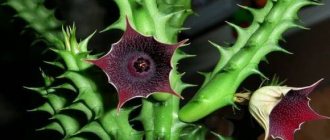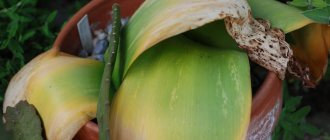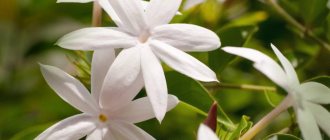Lighting and temperatures
Cryptanthus has virtually no complaints about the level of illumination.
The only caveat: the midday sun in summer can cause burns; it is better to shade the flower a little. Patterns and designs are always bright in sufficient light. They are indicators of well-being according to this parameter. Very shady places in the house are not suitable for cryptanthus.
https://www.youtube.com/watch?v=ytcopyrighten-GB
In summer, for the heat-loving cryptanthus, the most comfortable temperatures are around 23°C, then with a smooth transition they are brought to winter temperatures of 18°C for the dormant period from October to February.
Sudden temperature changes of even 4 degrees and drafts are detrimental to cryptanthus.
Reproduction of Cryptanthus:
Cryptanthus propagates by separating suckers, side shoots after the flowering period, and by seed. Cryptanthus roots are very fragile, keep this in mind when working with them. When propagating, you should not deepen the neck of the plant’s rosettes too much to avoid rotting. The offspring are usually separated after the mother plant has flowered and begins to die. The offspring must reach 10-20 cm in height and does not necessarily have roots; sometimes they themselves fall off from the mother plant. Separation from the mother plant is carried out using a knife, while the sections are sprinkled with crushed coal and dried for 8-12 hours. Then they are seated in separate containers. Seed germination is carried out in sphagnum moss in a greenhouse at a temperature of 22-25 °C. The seeds are not buried in the soil and are treated in a weak solution of potassium permanganate before planting. The greenhouse is regularly ventilated and sprayed. When the seedlings have 2-3 leaves, on average this happens within 4 months, a pick is made.
Luxurious leaves and hidden talents of cryptanthus
Like all bromeliads, cryptoanthus are stemless plants. These are Brazilian endemics that have spread throughout the world as greenhouse and indoor crops. The attractiveness of the leaves and unusual colors have made Cryptanthus a favorite in landscaping modern interiors.
The good news is that our domestic insects are practically not interested in this exotic insect.
True, flower growers sometimes encounter plant diseases.
It could be:
- rot, root or leaf (occurs with frequent overflows; cold or draft can aggravate the situation);
- wilting of leaves - when, on the contrary, there is too little water for the plant;
- sunburn - if the direct rays of the sun manage to fall on the leaves and this happens every day (such burns can be recognized quickly - they look like brown spots);
- dry tips of leaves - in dry air.
Cryptanthus is a prominent representative of the Bromeliad family. Many relatives of this plant are also known in our country.
Source
About caring for Cryptanthus at home:
Temperature: The optimal temperature for Cryptanthus in summer is 18-24°C, and in winter the temperature should not fall below 15 ºC. The plant must be protected from the slightest drafts. In winter, the plant should not be kept on a cold windowsill.
Lighting: Cryptanthus prefers western or eastern lighting; it should be shaded from direct sunlight on a south window. Cryptanthus tolerates partial shade, but the bright color of the leaves is lost. In winter, additional illumination with fluorescent lamps is recommended.
Air humidity: Cryptanthus needs high air humidity. In summer, spraying is necessary and in hot weather you need to give him a warm shower. In winter, spraying should be reduced to once a day in the morning. Humidifiers can be used. It is not recommended to wipe the leaves.
Fertilizers: It is necessary to fertilize during the period of active growth, from spring to autumn, once a month with a mineral complex fertilizer for flowering crops in a half dose. You can use a specialized fertilizer for Bromeliads.
Pests of Cryptanthus: Can be affected by scale insects, whiteflies, spider mites, and aphids. When a fungal disease occurs, the core of the plant rots and the leaves turn black, easily separating from the plant. In order to cure a plant, you need to prepare a fungicide solution and pour it into the core of the plant. After the procedure, a side shoot usually appears, and the diseased plant must be removed with a knife.
Watering and humidity
Cryptanthus requires high air humidity, so it is often used in terrarium compositions and in wet greenhouses.
In indoor conditions, it is often sprayed up to three times a day, the leaves are wiped, a shower is arranged, and containers with water and wet stones are placed nearby.
The soil in the pot should always be kept moist.
It is strictly forbidden to water into the outlet itself - this is a feature of cryptanthus from most bromeliads. Abundant watering is indicated in summer, but in winter it is better to moderate it. Take only soft water and room temperature.
https://www.youtube.com/watch?v=ytadvertiseen-GB
Drought and flooding are detrimental to cryptanthus.
Cryptanthus growing conditions
For the unpretentious cryptanthus, the best habitat, besides the natural one, can be a botanical garden, a terrarium, or a warm greenhouse. It will feel unsurpassed even at home with inexperienced gardeners. And for this you need to provide normal care and comply with growing conditions.
In an artificial environment, Cryptanthus requires nutritious soil. The simplest flower pots will do for growing. Good drainage is necessary. Such a flower can hardly be called capricious. Its main requirement is high environmental humidity. Cryptanthus is a good addition to a miniature garden in a bottle with a flower arrangement.
It is also possible to grow the plant on pieces of wood. In this case, the roots of the cryptanthus are wrapped in moss and carefully secured to a support with wire. At least once every 10 days, the flower is removed from the tree and carefully immersed in water until completely saturated.
Lighting and temperatures
Cryptanthus has virtually no complaints about the level of illumination. The only caveat: the midday sun in summer can cause burns; it is better to shade the flower a little. Patterns and designs are always bright in sufficient light. They are indicators of well-being according to this parameter.
In summer, for the heat-loving cryptanthus, the most comfortable temperatures are around 23°C, then with a smooth transition they are brought to winter temperatures of 18°C for the dormant period from October to February.
Plant a lush, vibrant lawn in just 1 hour!
With Hydro Mousse liquid lawn, you just need to connect the sprayer to a regular garden hose and enjoy a lush and smooth lawn.
More details
Sudden temperature changes of even 4 degrees and drafts are detrimental to cryptanthus.
Watering and humidity
Cryptanthus requires high air humidity, so it is often used in terrarium compositions and in wet greenhouses.
In indoor conditions, it is often sprayed up to three times a day, the leaves are wiped, a shower is arranged, and containers with water and wet stones are placed nearby.
The soil in the pot should always be kept moist.
It is strictly forbidden to water into the outlet itself - this feature distinguishes Cryptanthus from most bromeliads. Abundant watering is indicated in summer, but in winter it is better to moderate it. Take only soft water and room temperature. Drought and flooding are detrimental to cryptanthus.
Soil and replanting
Cryptanthus has a small root system, so it is grown in pots with a small diameter. The plant is widely used by interior designers, cultivating it in vertical wooden containers with natural or artificial recesses. The substrate in this case is sphagnum moss.
Cryptanthus is poisonous, so all work caring for it must be carried out with gloves. Children and animals must be protected from it.
The soil for cryptanthus is prepared loose, well-permeable, with low acidity. The composition includes: pine bark, moss, peat, humus. You can purchase ready-made soil specifically for bromeliads or epiphytes. The drainage layer in the pot occupies a third of the height.
The transplantation procedure is carried out as needed at any time of the year if the cryptanthus becomes cramped in the pot.
Cryptanthus practically does not need replanting. It can grow in the same soil for a long time. The reason for replanting is to change the container as the flower grows. But due to the fact that the plant grows slowly, some gardeners do not replant it at all.
During flowering, the active process of shoot formation begins. In this case, additional space may also be needed.
To grow a flower at home, you can use a regular plastic container. The plant is unpretentious to the material of the flower pot.
Feeding and pruning
Starting in April and throughout the summer, twice a month Cryptanthus needs special fertilizer for bromeliads. If you take other fertilizers, they must contain minimum levels of nitrogen, and it is recommended to dilute them in water twice as much.
Sanitary pruning of cryptanthus is carried out as necessary, removing dead parts of the plant.
Problems and diseases
The plant can be damaged by spider mites and whiteflies. Pests are removed using a damp cloth soaked in a soap solution, and the plant is treated with an insecticide.
Possible problems with cryptanthus:
- Leaves dry out - low humidity, insufficient watering or hard water.
- Pale leaf color means poor lighting.
- Rot at the base of the plant is caused by waterlogging of the soil or low air temperature.
- Droopy leaves mean lack of moisture in the soil.
- Light brown spots on the leaves are sunburn.
Proper maintenance of cryptanthus is the key to its health. The plant is disease resistant.
The plant has a strong immune system that protects it from dangerous pests and diseases.
Berry "FAIRY GATHERING"
Buy now at a discount and get your first harvest in 3 weeks. Enjoy fresh and delicious strawberries all year round!
Buy at a discount
Plant care
Cryptanthus is not a 100% epiphyte. It will not grow on pure pine bark - provide this crop with a nutrient substrate. And the flower needs not a flat pot, but an ordinary one, because its root system is quite developed.
Earth star is not considered a picky plant. The only thing that the owner of a cryptanthus should not forget about is that the flower loves moist air.
A good option for growing this crop: a florarium or terrarium (a semi-closed or fully closed glass container). For cryptanthus, you can buy an empty round aquarium, a decorative bottle, and even an empty glass.
This plant is unpretentious to light. The main thing is that the rays do not fall directly on the leaves - there will be a burn.
Moreover: in winter, cryptanthus may not have enough light. An ideal source of additional lighting would be a fluorescent lamp.
In general, you can keep a flower pot on any windowsill. But if you choose the southern one, seriously shade the earthen star, especially in the summer sun.
Cryptanthus respects moderate heat. In winter it needs at least 18 degrees, in summer - about 23 degrees.
Water treatments
Greenhouse high air humidity is the standard of life for cryptanthus.
To make your plant happily turn green (or red, white, depending on its appearance), you can:
- wipe the leaves with a damp cloth every day;
- spray your pet daily;
- keep the pot on a tray/pallet with watered expanded clay (but this is more likely as an addition to spraying).
Once the top of the soil is dry, water the cryptanthus thoroughly. But this is from the beginning of spring to the beginning of autumn. In the autumn-winter period, the plant needs less water. In the cold season, you will see that the soil in the pot has dried out - wait 2-3 days, and only after that take out the watering can.
The soil in the pot should not dry out completely or become waterlogged.
Water should always be at room temperature or slightly warmer. Take filtered or settled liquid.
Check the tray 20 minutes after watering. All excess water not used up by the flower will flow there. Drain it immediately.
Soil selection
Since water cannot linger in the pot, the soil for this ornamental crop must be soft.
You can buy substrate for Bromeliads.
Want to create the soil yourself? Here is a proven “recipe”: 3 shares of fine pine bark, a share of high-moor peat, deciduous soil, moss, 0.5 shares of humus.
And don’t forget about drainage - it should take up at least a third of the pot.
Yes, but only from mid-spring to early autumn.
Dilute flower fertilizer for Bromeliads 1-2 times a month. If you don’t find this on sale, look for another fertilizer for indoor flowers, but only with a low percentage of nitrogen.
The older the plant, the wider the pot, because if the cryptanthus decides to bloom, it means it will soon grow babies on the sides.
READ MORE: Design of a small kitchen with a refrigerator in Khrushchev 39 photos of where to put a corner kitchen set How to choose furniture for a small kitchen
In general, this green pet grows very slowly, so that it can “live” in one pot.
Cryptanthus is called the main competitor of Sansevieria in modern interiors. These crops are indeed very similar in their ability to serve as expressive accents in landscaping. But unlike Sansevieria, Cryptanthus is much more demanding on lighting and does not tolerate significant shading. Caring for cryptanthus is simple, but requires constant maintenance of humidity.
Air humidity is of particular importance for cryptanthus, so they are often recommended to be grown in flower displays and greenhouses, but the necessary conditions can be recreated in traditional indoor conditions. And with a wide range of ornamental species to choose from, you can find the perfect plant to suit the style and color scheme of every room - from conservatories and bathrooms to living spaces and offices. Moreover, cryptanthus goes well with most large-leaved plants.
Luxurious Cryptanthus are quite flexible in their ability to adapt to different lighting conditions, but not to the same extent as the best hardy houseplants. Cryptanthus will only be comfortable growing in a sunny, light or slightly shaded location. Plants cannot tolerate direct sunlight or strong shading, losing their characteristic color and suffering from various problems.
Cryptanthus is suitable for indoor growing and requires minimal care at home. The plant feels good in a bright or slightly shaded room. Bright midday sun can cause foliage scorch. With a lack of light, the variegated color of the leaves becomes less expressive. In winter, it is recommended to illuminate the cryptanthus with a lamp.
The optimal air temperature for an adult plant is 20... 24°C. In winter, it is recommended to lower the temperature to 15... 18°C. Cold weather down to 10...12°C can be detrimental to the plant. In summer, you can take the pots out onto the balcony or into the garden, but drafts should be avoided.
An inhabitant of the tropics needs high air humidity. Lack of moisture manifests itself in dry tips of foliage. The plant can be placed near aquariums or small fountains. It is recommended to spray the leaves regularly. In extreme heat, you can place pallets with wet pebbles or expanded clay nearby. It is also a good idea to wipe the leaves with a wet cloth or take a warm shower.
Cryptanthus requires regular and abundant watering, but excess water should immediately leave the pot. The plant is planted in containers with large drainage holes and a thick drainage layer. Only the top layer of soil should dry out, otherwise the leaves will begin to dry out. Cryptanthus needs regular fertilization during spring and summer. Fertilizer for bromiliaceae is added to water for irrigation twice a month.
https://www.youtube.com/watch?v=ytabouten-GB
Transplantation is carried out as needed (usually every 2-4 years). For planting, select small pots according to the size of the rhizome. You can buy soil in the store (substrate for Bromiliaceae) or prepare it yourself from the following components:
- pine bark (3 parts);
- sphagnum moss (1 part);
- peat (1 part);
- leaf soil (1 part);
- leaf humus (0.5 parts).
The drainage layer of brick chips, expanded clay or pebbles should be at least a third of the height of the pot.
Cryptanthus has good immunity to known diseases and parasites, so it does not require additional processing.
Cryptanthus is one of the smallest representatives of the Bromeliaceae, which comes from Brazil. It is very difficult to confuse it with other plants of this family, since it has the most varied leaf colors. These are stemless plants and from the outside they look like a starfish; it is not for nothing that in their homeland they call it “earth star”.
The name of the plant comes from two Greek words krypto - to hide, anthos - inflorescence, flower. Cryptanthus begins to bloom in July-August and at first glance it is hardly possible to notice its flowering; it is very well and deeply covered with leaves. Like all bromeliads, after flowering the rosette dies, but by this time the plant has formed many offspring, daughter shoots.
Because of its unique appearance, Cryptanthus is often used to decorate terrariums and florariums. At home, small gardens are created in semi-closed containers, in large glasses or simply in empty glasses where Cryptanthus takes pride of place. You can read about creating a florarium and a garden in a bottle with your own hands in a separate article: We create a garden in a bottle and a florarium with our own hands.
[ads4]Unusual and bright cryptanthus is becoming increasingly popular among gardeners and interior designers. Its bright, eye-catching rosettes of leaves can decorate any modern interior.
Cryptanthus looks great either alone or in combination with other plants. It is not very demanding to care for and is quite hardy.
Cryptanthus, or Crypthanthus in Latin, is the shortest member of the bromeliad family, numbering about 20 species in its genus. It is a stemless herbaceous plant that grows on the ground, unlike other bromeliads, which are most often epiphytes.
The plant’s homeland is Eastern Brazil, where you can find forest glades completely covered with a bright carpet of “earth stars.” Cryptanthus acquired this beautiful name due to its unusual appearance.
Its leathery leaves form a rosette, similar to a multi-colored star of many rays, painted in bright colors from light green to dark burgundy. All types of cryptanthus are decorated with longitudinal or transverse stripes.
The miniature white flowers of Cryptanthus are extremely difficult to see on the plant. They are collected in small spike-shaped inflorescences and skillfully hide among the leaves. It is not for nothing that the name cryptanthus translated means “to hide a flower.” Five main plant species are grown indoors, from which many ornamental varieties have been bred.
Cryptanthus bivittatus Red Star. A popular variety bred on the basis of Cryptanthus bistriata.
READ MORE: Schlumbergera - care and propagation at home, photos of varieties
This is a spectacular plant with lanceolate leaves collected in a rosette with a diameter of no more than 15 cm.
https://www.youtube.com/watch?v=ytcreatorsen-GB
The leaf plate with wavy edges is decorated with longitudinal stripes of rich burgundy shades. Cryptanthus bistriata rarely blooms.
Cryptanthus acaulis. A species with a compact green rosette of narrow-lanceolate leaves with small sharp teeth along the edges.
The reverse side of the leaf plate is covered with small scales. Begins to bloom at different times of the year.
Cryptanthus spp.
Stemless Kryptanthus (Kryptanthus acaulis)
Perennial Brazilian stemless herbaceous flower. The narrow lanceolate shape of the leaf blades makes the plant unusual. The length of the green leaves reaches twenty centimeters. They are slightly pointed towards the top, the edges are jagged, and the underside of the leaf is scaly. 15 pieces of these beauties form a spreading rosette, in which small white flowers are hidden, rare flowers are collected in inflorescences, framed by wide oval bracts.
Kryptanthus bivittatus
Characteristic of Cryptanus bistriata is a long-term life span and a herbaceous form of vegetation. Beautiful ten-centimeter light green, jagged and wavy leaves are decorated with two longitudinal stripes. They gather into a dense miniature rosette, the diameter of which is fifteen centimeters. Occasionally the plant blooms with very discreet white flowers.
Kryptanthus zonatus
The spreading rosette is assembled from lanceolate leathery leaves 20 cm long and up to 3 cm wide. And they attract attention with the extraordinary patterning created by multiple whitish or yellowish fluffy plates that create transverse stripes. A few white three-centimeter flowers form a complex, head-like, spike-shaped inflorescence.
Kryptanthus fosterianus
A perennial exotic native to Eastern Brazil. It is similar to the transversely striped cryptanthus. A distinctive feature is the longer leaves, up to 40 cm, and narrow leaves, up to 4 cm. Very colorful with wavy edges, red-brown leaves with zigzag stripes with a silver tint, the back of which is scaly, form an irresistible rosette. Blooming cryptanthus forms complex capitate inflorescences with outer four-flowered and inner two-flowered spikes. The color of the petals is white.
Kryptanthus bromeliodes
This species is distinguished by the presence of a stem clothed in hard, wavy leaves with a finely serrated edge ranging from green-bronze to red-copper in color. The upper side of the leaf is smooth, and the back is scaly. The spikelet-like inflorescence is decorated with white linear flowers.
Pruning cryptanthus
If your plant has dry leaf tips, it is best to trim off the dead parts. This cleaning is carried out in the same way as on date palms or sansevierias: not the entire dry part is cut off, but leaving a thin strip near the living tissue.
Starting in April and throughout the summer, twice a month Cryptanthus needs special fertilizer for bromeliads. If you take other fertilizers, they must contain minimum levels of nitrogen, and it is recommended to dilute them in water twice as much.
Sanitary pruning of cryptanthus is carried out as necessary, removing dead parts of the plant.
Cryptanthus bistriped "Ruby".
Watering Cryptanthus
:Cryptanthus needs regular watering. It is necessary to water with warm, soft, settled water at room temperature. The frequency of watering depends on the temperature of the content. In summer, water generously and ensure that the soil is evenly moist. The top layer of soil should not dry out. In autumn and winter, watering is reduced because the soil takes longer to dry out, but if signs of drying appear on the surface of the substrate, it must be sprayed. Water should not stagnate in the pot or pan as this can lead to rotting of the roots. All Bromeliads are sensitive to chlorine, so the use of tap water to care for the plant is strictly prohibited, as this can lead to the death of the plant.
Soil and replanting
Cryptanthus can be transplanted at almost any time in the first half of the season - from March to August. But it is better to carry it out when necessary, when the plant really becomes cramped in the container allotted to it. The drainage for cryptanthus should be very powerful, occupying at least a third of the height of the container.
Cryptanthus require a substrate with a pH of about 5.0. The texture also needs to be paid attention to: rough, peaty soil with increased looseness will be the best habitat for cryptanthus. You can use a ready-made substrate for epiphytes. For this plant, the breathability of the substrate is more important, which is why it is so important to use soil mixtures with a rough texture. Diseases and pests
Cryptanthus sometimes suffer from thrips and spider mites, but infection threatens the plant only if comfortable growing conditions with high air humidity are violated.
The soil for cryptanthus is prepared loose, well-permeable, with low acidity. The composition includes: pine bark, moss, peat, humus. You can purchase ready-made soil specifically for bromeliads or epiphytes.
The drainage layer in the pot occupies a third of the height.
https://www.youtube.com/watch?v=ytdeven-GB
The transplantation procedure is carried out as needed at any time of the year if the cryptanthus becomes cramped in the pot.
Description of the plant and its variety
Cryptanthus is a very unusual plant, unlike other representatives of the same family. The leathery leaves of the culture form a rosette, which is very reminiscent of a multi-colored star with many rays. The foliage has different colors - from light green to dark burgundy. Cryptanthus leaves are decorated with longitudinal or transverse stripes. The culture is blooming inconspicuously. Small white flowers are rarely seen on the plant. They are collected in spike-shaped arrows and are well hidden between the leaves. There are 5 main types of cryptanthus grown indoors, from which many decorative varieties have been obtained. Let's take a closer look at them.
Cryptanthus stemless
The species is most often grown at home. This perennial does not have a stem or it can be very short. The leaves are wavy and have a pointed edge. They can reach 22 cm in length. The edges of the leaves are equipped with sharp teeth. The leaf blades are decorated with stripes of green and lighter shades. The culture blooms with white inflorescences.
Cryptanthus bistriata
The leaves of this variety are not very long - from 6 to 11 cm. The bush that the leaves form is small in size - up to 17 cm in diameter, but has a high density. The edges of the pale green leaves have small teeth. There are varieties in which the leaves are pink-red. Their stripes are light or green. They bloom with white, inconspicuous flowers. Due to its compact appearance, the Bistriped Cryptanthus is sometimes placed in a beautiful glass aquarium.
Cryptanthus bromeliad
Unlike other species, it has a short trunk. The wavy leaves come in a variety of colors, from coppery red to green.
In the store you can purchase the spectacular “Tricolor” variety. Its leaves have stripes of green, white and pink-red.
Cryptanthus striated
The leaves of this variety have an original transverse color. Their length sometimes reaches 20 cm. The bush has many transverse stripes of white or yellow color on a dark green background. The culture blooms with small white flowers. A large number of plant varieties have been developed that differ in both color and transverse pattern.
Cryptanthus Foster
This variety is similar to the striated variety, but its leaves are narrower and longer. They can reach 40 cm in length. The leaf blades have finely serrated edges. The color of the leaves is usually brown-red, with zigzag stripes of silver or light green.
Diseases and pests
If not properly cared for, cryptanthus can be affected by diseases or pests. Sometimes rotting of the leaf rosette occurs, which occurs as a result of excessive watering at low air temperatures. It is necessary to reduce watering and move the plant to a warm room.
Leaf discoloration or fading of color is usually caused by insufficient light. The situation can be improved if you move the pots with the plant to a more illuminated place.
If Cryptanthus is too hot, its leaves begin to curl, dry out and change color to brown. This may be a sign of lack of light, moisture, or rotting roots.
The appearance of brown spots on leaves is usually a symptom of burns.
Among the pests, Cryptanthus can affect:
- whitefly;
- scale insects;
- root mealybug;
- spider mite
The appearance of whiteflies can be judged by the white coating on the leaves. It can be destroyed using insecticides. Scale insects appear as small brown dots on the underside of the leaf. If there are few of them, it would be more advisable to collect the parasites manually. If the pests have managed to multiply, then only treatment with an insecticide, for example, Actellik, will help.
Root bugs and spider mites can be removed manually and, for prevention, the crop can be treated with a soap solution. If there are too many pests, you will have to resort to treatment with an insecticidal solution.
Pests appear on the plant due to disturbances in the indoor microclimate. For example, whiteflies love warm, moist air in a poorly ventilated room. Dry air with high air temperatures is ideal for spider mites. Prevention of the appearance of parasites is ventilation and moderate room temperature.
With proper care, cryptanthus will delight owners with its bright, unusual colors. Exotic varieties of this plant can create a real sensation among guests. Cryptanthus is a real find for exotic lovers. In addition, a wide selection of different colors and sizes will allow you to choose the best option.
marked
Your opinion is very important to us. Please rate the article: rated 1 , rating: 5.00 out of 5
See also related articles
Echmea striped: care at home
Bilbergia: care at home
Tillandsia Anita: home care
Vriesia: care at home
Bromeliad: home care
Add a comment Cancel reply
You must be logged in to post a comment.
✿ Alphabetical index
✿ Categories
- Houseplants
- Bromeliads
- Decorative foliage
- Trees and shrubs
- Orchids
- Succulents
- Blooming
- Perennial
✿ Popular articles
- How to grow chestnut from a nut at home in a pot
- Clematis: care and cultivation in the garden
- How to grow pomegranate from seeds at home to produce fruits
- How to grow lemon from a seed at home with fruits: step by step
- Decembrist flower: care at home, how to water correctly
- Hedera "Helix mix": home care
✿ Latest comments
- Lyudmila on How to grow a lemon from a seed at home with fruits: step by step
- Tatyana on Tillandsia Anita: care at home
- LOVE for the entry Tulips: care and cultivation in the garden
Copyright © 2018-2021 GARDENER'S BOOK.
0+ By using bookgardener.ru you accept the terms of the USER AGREEMENT. Copyright for the posted materials belongs to the editors of the online magazine. When reprinting and using materials, an active hyperlink to BookGardener.ru is required
Cryptanthus propagation
Cryptanthus can be propagated using “kids” or seeds.
Daughter plants usually grow at the base of the mother cryptanthus. When they reach a height of more than 10 cm, they are carefully separated with a sharp knife, and the cut is treated with charcoal. Often the “babies” separate on their own. After the cut dries, the young plants are planted in a substrate consisting of sand, pine bark and leaf soil or in ready-made soil for bromeliads.
It is advisable to send the container with young bushes to greenhouse conditions - under film or glass. Plants need to be ventilated once a day. It is better to carry out the procedure in the spring - at this time the probability of taking root is higher.
The abandoned children of Cryptanthus
Cryptanthus can also be propagated by seeds. They are sown in a mixture of sand and moss, and then covered with film. At a temperature of 24°C, sprouts will appear in about 3 weeks. Emerging plants remain at the same size for a long time - first they develop their root system. Seedlings can be fed only two weeks after their appearance. When 3-4 leaf plates appear, the young bush is transplanted into separate containers. To create a lush composition, some people plant 2-3 plants in a pot. Next time they are replanted only by transshipment, so as not to damage the intertwined root system.
Cryptanthus propagation
The plant produces children that replace the mother bushes, and numerous small rosettes can be used for active propagation. After flowering, when the maternal rosette dies, numerous offspring appear from the renewal buds, which form up to 4 leaves within 6-8 weeks. They can be carefully separated from each other and used as independent plants. For cryptanthus, high-quality soil with a suitable texture is used, and plants transplanted from the mother's rosette must be placed in hot conditions with a temperature of about 26-28 degrees, under a cap or film, before rooting and adaptation. In a bright place, protected from direct sunlight and daily ventilation, the plants will gradually become stronger and can be transferred to the regime familiar to adult cryptanthus.
To obtain new Cryptanthus from seeds, only freshly harvested seeds can be used. They are rooted under a film in a mixture of sand and peat at the same high humidity and temperature as when rooting children.
Sources:
https://floplants.com/bromelievye/kriptantus-uxod-peresadka-razmnozhenie/ https://bookgardener.ru/komnatnye-rasteniya/bromelievye/kriptantus-uhod-v-domashnih-usloviyah.html https://bigsovets.ru /roskoshnye-listia-kriptantysa/
Features of care
Cryptanthus has a small root system, so it is grown in pots with a small diameter. The plant is widely used by interior designers, cultivating it in vertical wooden containers with natural or artificial recesses. The substrate in this case is sphagnum moss.
Cryptanthus is poisonous , so all work on caring for it must be carried out with gloves. Children and animals must be protected from it.
Selecting a location and temperature
The ideal place to place a cryptanthus is an eastern and western window with bright and diffused light. On a south-facing window, the plant will need light shading.
In the cold season, it is advisable to place the cryptanthus on the lightest windowsill, no longer shading it from the winter sun. “Earth star” can grow well in partial shade, but this will negatively affect the color. The more light, the more contrast and brighter the pattern on the leaves of the cryptanthus.
The optimal temperature for the plant in summer is from 18 to 24 ° C, and in winter - from 18 to 20 ° C, which is easily achievable in room conditions. It should be remembered that the plant does not like drafts and sudden temperature changes.
Watering and humidity
In summer, you should water your cryptanthus deeply two or three times a week. In winter, watering is reduced to once every 10 days. It is important not to allow water to stagnate in the pan. Half an hour after watering, you must drain the water from it.
During the hot season, cryptanthus must be sprayed frequently . It doesn’t hurt to place the container with the plant on a tray with wet filler, but making sure that the bottom does not touch the water.
Too dry air causes the tips of the leaves of Cryptanthus to dry out , which should be cut off without touching the healthy area. The plant does not welcome rubbing of the leaves.
Soil composition and replanting
The soil for the plant should be loose and breathable. The ideal option is a purchased mixture for bromeliads. Drainage should occupy one third of the height of the pot.
A self-prepared mixture of the following components is suitable as a substrate:
- 1 part of high-moor peat;
- 0.5 parts of leaf humus soil;
- 3 parts pine sawdust;
- 1 part sphagnum moss.
Cryptanthus has a weak root system , so it is replanted only when necessary.
In addition, after flowering, the mother rosette dies , leaving “babies” nearby for reproduction. If desired, the cryptanthus can be transplanted into a wooden container, which is now very fashionable in the interior.
To do this, you need to take a suitable piece of root or bark and make a depression in it. Next, you should remove the plant from the pot, wrap its roots with sphagnum moss and place it in a hole, not forgetting to periodically spray the cryptanthus and moisten its roots.
Top dressing
In summer, it is recommended to feed the plant once a month with a small amount of mineral fertilizer for flowers or specifically for bromeliads.
The dosage of nutrients should be half that indicated in the instructions. Fertilizers are added to water for irrigation.











